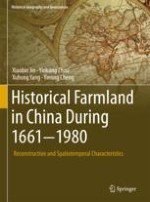This book explores various approaches to reconstruct the spatial and temporal distribution of historical farmland in China. The book contains background information about political regimes, economic and social development, population changes and land resource utilization in the past 300 years in China. A literature review focuses on the assumptions, methodologies and models of reconstructing historical land-use datasets while addresses accuracy evaluation issues. Historical population size, its growth rate, and the evolution of spatial-temporal patterns of farmland in China have also been discussed. Almost all available historical data about farmland such as historical documents, archives, taxation records, statistics and research outcomes have been collected to reconstruct the amount of historical farmland. With a few principles and assumptions, a delicate Cellular Automaton (CA) and Multi-Agents (MAS) model based on bottom-up management scheme has been applied to derive the spatial-temporal distribution of farmland with the 1km*1km grid resolution for the period between 1661 and 1980 in China. Suggestions for future studies related to reconstructing historical land-use changes are then provided.
